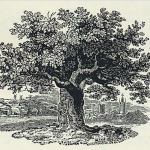My last article described the political turmoil in Hunterdon County in the 1850s. There was another kind of turmoil going on at the same time, an economic one. For Hunterdon that meant a local bank was needed.
debt
The Conklings, Father and Son
This is a continuation of the story by Egbert T. Bush of the “Biggest Log Ever Brought to Stockton,” in which he wrote about the owners of the Stockton Sawmill and the Stockton Spoke Works. These Hunterdon industrialists took risks to build their businesses, and sometimes failed badly. Here are two more examples of failure and success.
Biggest Log Ever Brought to Stockton
Giant Oak Caused Trouble Before It Arrived at the Mill.
A Big Event in the Town
by Egbert T. Bush, Stockton, N.J.
published in the Hunterdon Co. Democrat, September 5, 1929

This is another in a series of articles by Egbert T. Bush on the subject of Hunterdon County trees. Whenever Mr. Bush writes about an event, there is always an interesting back story—often more than one. This article about Stockton takes us north to Kingwood and Alexandria, and south to Lambertville. There are a few people of particular importance: John Finney, William V. Case, Edward P. Conkling and his father Rev. Cornelius S. Conkling. The biographies of Finney and Case can be found at the end of Mr. Bush’s article. The Conklings will appear in a subsequent post.
Samuel G. Opdycke Esq., continued
For the first part of this story, please visit Samuel G. Opdycke Esq.
Samuel G. Opdycke was a young man of promise. Thanks to the Opdycke Genealogy, we have a description of what he looked like, and, even better, we have a portrait:
Samuel Green Opdycke Esq.
“Ascending!
FINDING the room on the first floor of the Court House rather too much confined for an office, and the passage too much obstructed by lockage for the free ingress and egress of clients, I have selected, for a summer office, a beautiful airy chamber in the extreme front of the building. This pleasant apartment is situated immediately over the portico of this lofty edifice, and overlooks the main street of the village; After rising three inclined planes, clients will arrive at the summit level of my office; the door opens toward the east between two windows; No toll demanded until they arrive at the summit. – Passage back, free of expense; Samuel G. Opdycke, Flemington, May 19, 1830.”1
The Last Chapter of the Saxtonville Mill
After John R. Hamilton disappeared, leaving James Major, Mindert Wilson and Geo. Holcombe with the mill lot on their hands, the State Bank at New Brunswick sued either James Major or Mindert Wilson (I’m still not sure which) in chancery court for the outstanding mortgage. The court ruled in the Bank’s favor, and issued a writ of fieri facias to seize the mill lot at Saxtonville “whereon Myndert Wilson formerly resided,” along with its appurtenances (dwelling house, grist mill and saw mills), and offer them for public sale. Sheriff John Cavanagh conducted the sale on March 17, 1820. John Bray Esq. bid on behalf of the bank, and the property was conveyed to the State Bank at New Brunswick on April 1, 1820 for $4000.1
Saxtonville Mill Entangled In Debt
Myndert Wilson, who purchased the mill lot from George Holcombe for an outrageous $13,000, was smart enough to hand it off a year later to someone else. On March 22, 1815, two months after the Battle of New Orleans, he sold it to James Major of Kingwood.1
What Happened to Malakiah Bonham ?
Despite the scandal involving Malakiah Bonham and Mary Fox, Malakiah Bonham still had good relations with the Fox family.
Widow Mary Fox Goes to Court
Second Postscript to “The Will of George Fox 1754”
Following the death of George Fox in June of 1754, his executors were obliged, as was usually the case, to deal with debts related to the estate. Judging by the number of documents filed with the Court of Common Pleas of Hunterdon County, the executors must have worked nearly full-time on this job.
Postscript to George Fox (1700-1754)
On July 6th, I posted an article on the will of George Fox (iii) written in 1754. I used that will to describe some of what I knew about his widow and children and what happened to them after he died. But there was a lot I didn’t know, and I discovered some of it recently when visiting the County Archives at the Records Center in the County Complex on Route 12. What I found was a considerable amount of litigation over debts owed by the George Fox who died in 1754, and debts owed to him.